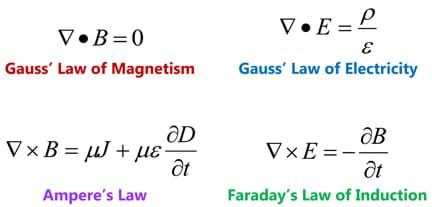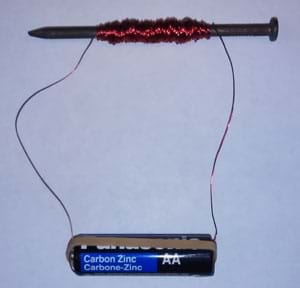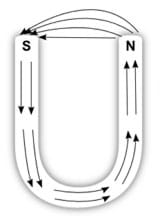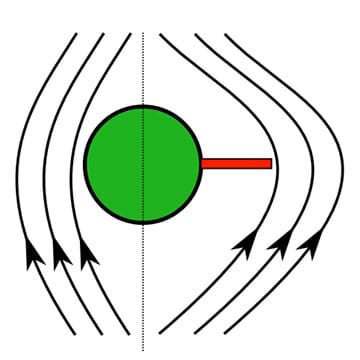Quick Look
Grade Level: 6 (5-7)
Time Required: 45 minutes
Lesson Dependency: None
Subject Areas: Physics, Science and Technology

Summary
Students are briefly introduced to Maxwell's equations and their significance to phenomena associated with electricity and magnetism. Basic concepts such as current, electricity and field lines are covered and reinforced. Through multiple topics and activities, students see how electricity and magnetism are interrelated.Engineering Connection
Throughout history, the subject of electricity and magnetism has been a topic of interest for physicists and engineers. Great minds such as Faraday, Gauss and Maxwell made discoveries that continue to shape the world in which we live. In particular, Maxwell's equations are used in nearly all engineering endeavors. For example, any time a person uses a TV, computer, cell phone or solar energy, Maxwell's equations are involved. This lesson's associated activities are prime examples of how Maxwell's equations are used for engineering purposes for the improvement and functioning of our daily lives. Electricity and magnetism pervasively affect modern industries such as communication, entertainment, medicine, defense and manufacturing.
Learning Objectives
After this lesson, students should be able to:
- Explain the interconnections that exist between electricity and magnetism.
- Describe how a changing magnetic field produces current in a loop of wire.
- Determine the factors that affect the strength of electromagnetic forces.
Educational Standards
Each TeachEngineering lesson or activity is correlated to one or more K-12 science,
technology, engineering or math (STEM) educational standards.
All 100,000+ K-12 STEM standards covered in TeachEngineering are collected, maintained and packaged by the Achievement Standards Network (ASN),
a project of D2L (www.achievementstandards.org).
In the ASN, standards are hierarchically structured: first by source; e.g., by state; within source by type; e.g., science or mathematics;
within type by subtype, then by grade, etc.
Each TeachEngineering lesson or activity is correlated to one or more K-12 science, technology, engineering or math (STEM) educational standards.
All 100,000+ K-12 STEM standards covered in TeachEngineering are collected, maintained and packaged by the Achievement Standards Network (ASN), a project of D2L (www.achievementstandards.org).
In the ASN, standards are hierarchically structured: first by source; e.g., by state; within source by type; e.g., science or mathematics; within type by subtype, then by grade, etc.
NGSS: Next Generation Science Standards - Science
-
DCI.PS2.B.6-8.1.
Electric and magnetic (electromagnetic) forces can be attractive or repulsive, and their sizes depend on the magnitudes of the charges, currents, or magnetic strengths involved and on the distances between the interacting objects.
(Grades 6 - 8)
More Details
Do you agree with this alignment?
-
DCI.PS2.B.6-8.3.
Forces that act at a distance (electric, magnetic, and gravitational) can be explained by fields that extend through space and can be mapped by their effect on a test object (a charged object, or a ball, respectively).
(Grades 6 - 8)
More Details
Do you agree with this alignment?
International Technology and Engineering Educators Association - Technology
-
Students will develop an understanding of the relationships among technologies and the connections between technology and other fields of study.
(Grades
K -
12)
More Details
Do you agree with this alignment?
Introduction/Motivation
The discoveries of Faraday, Gauss and Maxwell in the field of electromagnetism continue to shape the world in which we live today [1]. In particular, Maxwell's equations are used in nearly all engineering marvels, including TVs, computers, cell phones and solar cells.
Electromagnetic, or EM, devices are a major part of modern day -to-day life. Can you think of any examples? More than 99.9% of all electricity produced is created using electric generators, an EM device. Wireless communication, such as radio, TV, cell phones and Wi-Fi internet, are transmitted and received using EM devices. All electric motors, such as those used in blenders, hand drills and automated garage doors, are EM devices. Microwave ovens that heat our food are EM devices. Microphones and speakers are EM devices. Protective eye wear, such as sunglasses, are EM devices. CT scans and sanitation within hospitals are accomplished using EM devices. Video entertainment, from simple tube televisions to new 3-D, is presented using EM devices.
From this list, which is by no means comprehensive, you can see that the development of electromagnetics has and still does significantly influence our lives. In fact, it is nearly impossible to imagine life without EM tools and devices. The complete list would be too long to include here.
Also, beyond its engineering applications, EM affects us every day. All the energy that comes to us from the sun is EM energy. Every time we go outside we are hit with massive doses of EM energy. The twinkle of the stars in the distance is EM radiation that has taken millions of years to get to us. Not to mention that everything that has thermal energy, or heat, gives off EM radiation, including ourselves. It's everywhere and in everything.
So, what is electromagnetism? Electromagnetism is the study of the relationship between magnetism and electricity. Electromagnetics is the field of engineering that is focused on utilizing electromagnetism. All of electromagnetism is summed up in four equations (Gauss' law of magnetism, Gauss' law of electricity, Ampere's law, and Faraday's law of induction) known as Maxwell's equations.
It was around 1820 that Hans Christian Ørsted and André-Marie Ampère discovered the connection between electricity and magnetism. They noticed that a wire containing a current would deflect a compass needle when the two were close to each other. From this, it was determined that a current, or a flow of electrons, produces a magnetic field [2]. Later, many more findings relating the two phenomena came out. James Clerk Maxwell, a man who is noted as the third greatest scientist of all time (behind Newton and Einstein), compiled the findings of Ørsted, Ampère and many other scientists of that time. He was able to bring together all observable connections between magnetism and electricity into four basic equations. These are known as Maxwell's equations.
Maxwell's equations require a high level of mathematics to understand and apply. However, the concepts behind the equations can be understood by students of all levels. Knowing these concepts will help you have a better understanding of how the world works.
Lesson Background and Concepts for Teachers
The lesson presented herein is meant to provide a broad understanding of electromagnetics. Moreover, the associated activities provide students with the opportunity to manipulate basic forces of the universe. Though this lesson is focused on electromagnetics, it also fortifies other concepts such as electrical circuits, magnetic fields, and electric and magnetic repulsion and attraction.
James Clerk Maxwell (1831-1879)
This lesson (and its associated activities) is based on the equations derived and presented by Maxwell in the 1800s. Many people are not familiar with Maxwell and the importance of his contributions to science. To get an idea of how well regarded Maxwell is in the field of physics, the most influential physicists of our time were asked to list of the most significant physicists in history, and James Clerk Maxwell was third on this list, behind Einstein and Newton.

Maxwell is of Scottish origin and by trade a physicist and mathematician. Besides the equations, Maxwell is credited with other significant scientific discoveries such as producing the world's first color photograph, deducing the nature of Saturn's rings, and assisting in the formulation of the kinetic theory of gases. But many would agree his greatest work is in the field of electromagnetics. His equations unified into one theory all the phenomena of electricity and magnetism. The mathematical genius of Maxwell united the discoveries of Faraday, Ørsted, Coulomb, Ampère and Gauss.
Maxwell's Equations

- Gauss' law of magnetism shows that an isolated magnetic pole does not exist. All magnets have two poles designated as north and south. A single pole cannot exist in nature apart from its opposite.
- Gauss' law of electricity shows that isolated electric charges do exist. Therefore, the separation and isolation of positive and negative charges allows each to independently exist in nature.
- Ampere's law shows that a current through a wire produces a magnetic field that curls around that wire.
- Faraday's law of induction shows that a changing magnetic flux through a coil of wire induces a current to flow in that wire in order to produce a magnetic flux to oppose the changing magnetic flux.
Force, Field Lines and Magnets
A force is a push or pull that causes a change in motion of an object. These pushes can be due to contact, such as a person pushing on a rock, causing the rock to move. These pushes and pulls can also act at a distance, such as the gravity of Earth pulling an apple down out of a tree.
Field lines, or invisible lines of force, are a concept familiar to all of us. For example, we all know that we are bound to the Earth's surface by gravitational force. However, the force that keeps us from floating into space is invisible. We all know that when a negatively charged object is brought near a positively charged object an attractive force exists between the two objects. The force that exists between positively and negatively charged particles is also invisible. We can extend this discussion to magnets. When the north pole of one magnet is drawn near the south pole of another magnet, a force of attraction exists between the two poles and guess what? That force is invisible. To summarize, for each of the aforementioned forces, invisible force lines exist that show the direction in which the forces are acting.

We have all seen how magnets attract objects made of iron. Most of us are also familiar with the terms north and south poles that are associated with magnets. In any magnet, of any shape or size, the two ends where the magnetic effect is the strongest are called poles. If we take a freely suspended magnet and watch it align itself with the Earth's magnetic field, the end that points to the geographic north is deemed the north pole whereas the other end is the south pole. As discussed earlier, opposite poles of different magnets exert a force on each other. This is also true of like poles of different magnets. To determine how the force of one magnet is affecting another magnet, it is useful to draw magnetic field lines. Magnetic field lines are invisible lines of force that are able to tell us two things about a magnet: 1) the direction a north pole will be pulled at any point (a south pole will be pulled in the opposite direction with an equal force) and 2) the strength of the magnetic field. If we were able to see magnetic field lines we would observe that the lines point from the north pole of the magnet to the south pole of the same magnet or a different magnet. This concept is covered in the associated activity, Whose Field Line Is It Anyway?
In 1820, Danish scientist Hans Christian Ørsted discovered that a current carrying wire can produce a magnetic field. This phenomenon was determined when a compass needle was deflected upon being placed near a current carrying wire. This observation led to experiments to determine the orientation of magnetic fields produced by different wire geometries. One particular way to orient a current carrying wire is in a solenoid. A solenoid is a coil of wire used in an electromagnet. As current passes through the wire, a magnetic field is produced within the coil. In many instances, a magnetic core is inserted inside the coil to increase the strength of the magnetic field. As a result, an electromagnet is formed. Therefore, an electromagnet consists of a solenoid, a power source and a piece of iron placed inside the solenoid (see Figure 1). Electromagnets act just like regular magnets except that electromagnets lose their magnetic properties once current ceases to flow in the wire. In the associated activity, The Good, the Bad and the Electromagnet, students construct simple electromagnets and see what effect iron cores have on their strength.
Associated Activities
- Electricity & Magnetism: Whose Field Line Is It, Anyway? - Students use bar magnets, paper and iron shavings to reveal the field lines around magnets. They repeat the activity with electromagnets made by wrapping thin wire around a nail and connecting either wire end to a battery. Seeing that the magnetic field induced by electricity is no different than that produced by a bar magnet solidifies the connection between electricity and magnetism.
- The Good, the Bad and the Electromagnet - Students use straw, loose staples, wire, iron nails and batteries to make two versions of electromagnets—one with and one without an iron nail at its core. Testing reveals the importance of an iron core to the magnet's strength.
Vocabulary/Definitions
alternating current: In AC, the direction of electron flow constantly changes in direction; this is preferable to DC for home use since it takes less power to transport and is more efficient when producing.
Ampere's law: One of Maxwell's four equations; it states that a flow of electrons, or current, creates a magnetic field that circles around the direction of current.
charged: The characteristic of a particle to be susceptible to any of the basic forces (that is, gravity, electrical, magnetic); a higher charge means a greater susceptibility to the associated force; negatively charged means a reversed reaction to the force (that is, a negatively charged electrical particle moves the opposite direction of a positive particle when subject to the same electrical force).
direct current: In DC, the direction of electron flow is held constant; this is the kind of power that is produced in a battery.
electric field: A set of lines used for visualizing the force around a charged particle; the lines always point from a positively charged particle to a negatively charged particle.
electric generator: A device that converts mechanical energy (such as that coming from wind turbines) to electrical energy.
electrical current: A flow of electrons through a conducting material due to a force; it is similar to water current, which is the flow of water particles due to gravity or some other force.
electromagnet: A temporary magnet created by running a current through a coil of wire that is wrapped in a loop; usually this loop is wound around a piece of metal such as iron or iron compound.
electromagnetism: The sum of all relationships between electricity and magnetism.
Faraday's law of induction: One of Maxwell's four equations; it states that a changing magnetic field induces a current in a wire; this law is the basis for electric generators that are used in every power plant except solar power (that is, hydro, wind, oil, natural gas, nuclear, etc.).
field lines: Imaginary lines used to show direction of force. While most often used in magnetism, they are also used to illustrate electricity and gravity.
force: A push or pull that can cause a change in motion of an object.
Gauss' law of electricity: One of Maxwell's four equations; it states that particles exist that only contain one kind of electric charge (that is, negative or positive).
Gauss' law of magnetism: One of Maxwell's four equations; it states that particles do not exist that only contain one kind of magnetic charge (that is, south or north).
gravity: The energy and forces associated with gravitationally charged particles, such as all known matter; unlike electricity and magnetism, gravity is only known to have one charge and all charges attract.
magnetic: Relating to or caused by magnetism; having the properties of a magnet, that is, of attracting iron or steel.
magnetic field: A set of lines that show the direction of magnetic force; they can be seen by putting iron shavings around a magnet, and by knowing that they always point from the north pole of the magnet to the south pole.
magnetism: The energy and forces associated with magnetically charged particles, such as those found in bar magnets; due to the Earth having a magnetic field that consistently points in the same direction, magnets have for a long time been used in navigation; magnetism is due to the movement of electrically charged particles, such as electrons.
Maxwell's equations: Four equations (Faraday's law, Ampere's law, and two Gauss' laws) that describe the total relationship between electricity and magnetism; the equations are derived through observations in experimentation.
solenoid: A coil of wire used in an electromagnet.
voltage: The rate at which energy is drawn from a source that produces a flow of electricity in a circuit; expressed in volt
Assessment

Pre-Lesson Assessment
Informal Questions: Ask the students, and discuss as a class:
- What is an electromagnet? Hint: Split the word and go from there. (Answer: An electromagnet is any object that becomes a magnet when electricity is run through it, and stops being a magnet when the electricity is turned off.)
- How do you think that most of the electricity that we use is generated? (Answer: Most electricity is produced by moving a coil of wire and a magnet around each other. Less than 1% of the electricity is presently produced through chemical reactions and solar panels.)
Magnetic Field Lines of Arbitrary Shaped Magnets: When building a generator, you need a magnet and a coil of wire. To make sure the generator works properly, you must know the direction the field lines of the magnet are pointing. Tell the students that they are engineers in charge of designing a generator. They are given a horseshoe-shaped magnet. In order to proceed in construction, they must first determine the orientation of the field lines. Direct students to draw a magnet in a horseshoe shape. On the drawing, have them indicate which end would be the north pole and which end would be the south pole. Then give them several minutes to draw how the field lines would look for this particular shaped magnet. (Answer: See Figure 2. Magnetic field lines form closed loops, extending from the south pole to the north pole and back again. They are always drawn pointing to where the north pole is being pulled. They point in the opposite direction of where the south pole is being pulled.)
Electromagnetic Strength:
- With a partner, make a list of the factors that might affect the strength of an electromagnet, as pictured in Figure 1.
Answers:
- The type of coil/wire (that is, the lower resistance in winding material, the more powerful it will be)
- The number of windings of the coil (that is, more windings makes more powerful electromagnet)
- Stronger electrical power
- Less leakage fro the power from the windings (i.e. better insulation makes a more powerful magnet)
- Knowing the factors that influence strength of the electromagnet, do some research on the type of wire and insulation one could use to make a strong electromagnet.
Subscribe
Get the inside scoop on all things TeachEngineering such as new site features, curriculum updates, video releases, and more by signing up for our newsletter!More Curriculum Like This

Students learn about nondestructive testing, the use of the finite element method (systems of equations) and real-world impacts, and then conduct mini-activities to apply Maxwell’s equations, generate currents, create magnetic fields and solve a system of equations. They see the value of NDE and FEM...

Students teams each use a bar magnet, sheet of paper and iron shavings to reveal the field lines as they travel around a magnet. They see that the current flowing through a wire produces a magnetic field around the wire and that this magnetic field induced by electricity is no different than that pr...

Students induce EMF in a coil of wire using magnetic fields. Students review the cross product with respect to magnetic force and introduce magnetic flux, Faraday's law of Induction, Lenz's law, eddy currents, motional EMF and Induced EMF.

In this lesson about solenoids, students learn how to calculate the magnetic field along the axis of a solenoid and then complete an activity exploring the magnetic field of a metal slinky. Solenoids form the basis for the magnets of MRIs. Exploring the properties of this solenoid helps students und...
References
[1] Fowler, Michael. "Historical Beginnings of Theories of Electricity and Magnetism." Posted 1997. Galileo and Einstein, Physics, University of Virginia. Accessed November 30, 2011. (course lecture notes) http://galileoandeinstein.physics.virginia.edu/more_stuff/E&M_Hist.html
[2] Fitzpatrick, Richard. "Ampère's Circuital Law." Posted July 14, 2007. Electromagnetism and Optics, an introductory course at the University of Texas at Austin. Accessed November 30, 2011. http://farside.ph.utexas.edu/teaching/316/lectures/node75.html
Copyright
© 2013 by 2013 Regents of the University of Colorado; original © 2011 College of Engineering, University of South FloridaContributors
James Cooper and Mandek Richardson (under the advisement of Patricio Rocha and Tapas K. Das)Supporting Program
STARS GK-12 Program, College of Engineering, University of South FloridaAcknowledgements
This curriculum was developed by the USF Students, Teachers and Resources in Sciences (STARS) Program under National Science Foundation grant numbers DGE 0139348 and DGE 0638709. However, these contents do not necessarily represent the policies of the NSF, and you should not assume endorsement by the federal government.
Last modified: March 7, 2022









User Comments & Tips